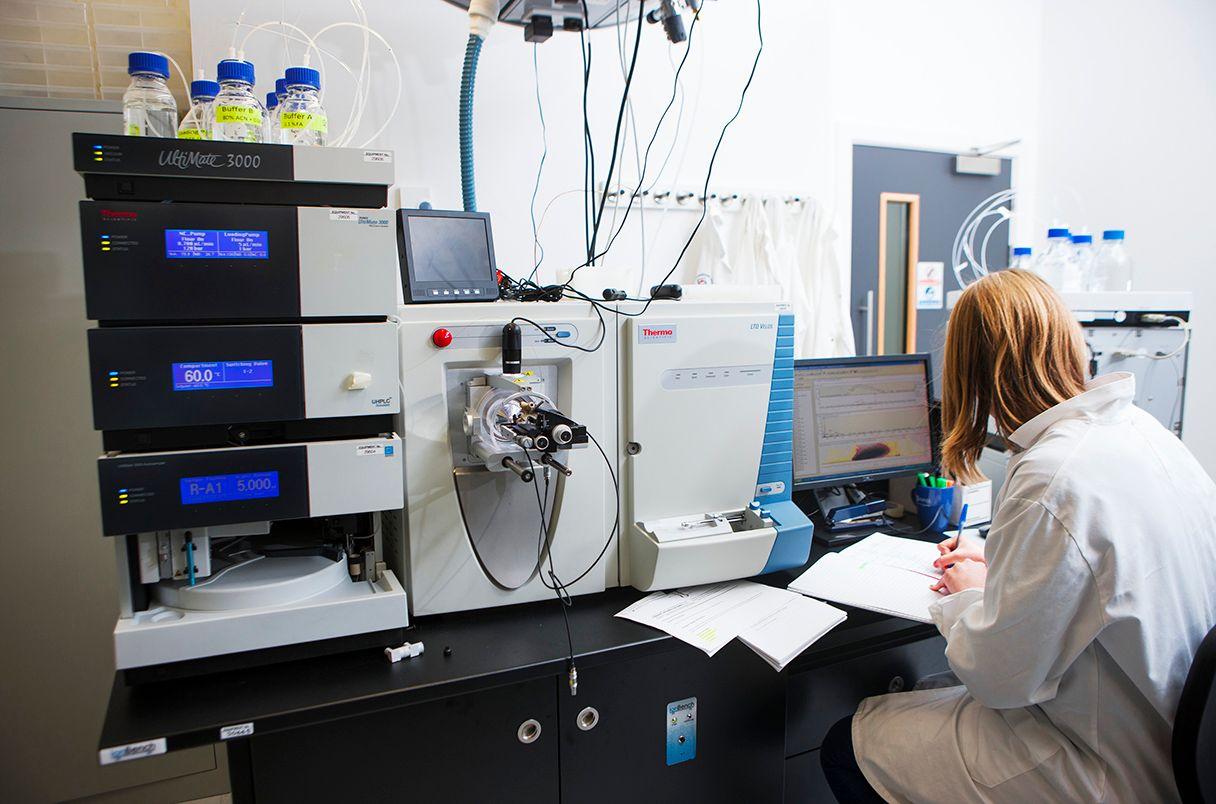AI-Powered Study Uncovers 400 Million Years of Enzyme Evolution
2 Sources
2 Sources
[1]
Study analyzes 400 million years of enzyme evolution
Enzymes catalyze chemical reactions in organisms -- without which life would not be possible. Leveraging AlphaFold2 artificial intelligence, researchers at Charité -- Universitätsmedizin Berlin have now succeeded in analyzing the laws of their evolution on a large scale. In the journal Nature, they describe the parts of enzymes that change comparatively quickly and the parts that remain practically unchanged over time. These findings are relevant to the development of new antibiotics, for example. Enzymes resemble nature's tiny little chemists: the nanometer-sized protein molecules ensure that chemical reactions can take place in every single cell of every organism. Unnoticed by most people, enzymes permeate our lives: they enable the digestion of food -- both for us and for microorganisms. Without enzymes, there would be no bread, no beer and no cheese. They are also at work in industry, as evidenced in the production of medicines and detergents. And likewise, enzymes play a pivotal role in the effectiveness and mechanism of action of many medicines. "We wanted to understand the rules according to which enzymes change their spatial shape over time," as study leader Prof. Markus Ralser, Director of the Institute of Biochemistry at Charité explains. "Because if we know these rules, we can predict, for example, where and how a bacterium will become resistant to an antibiotic." Many antibiotics and antifungal drugs are directed against specific enzymes of the pathogens they target. If these enzymes change their shape precisely where the respective active ingredient docks on, the drug will lose its effect. The same principle applies to numerous other drugs. Many cancer drugs target enzymes in the tumor that can change their shape during the course of treatment, rendering the drug ineffective as a result. An AI system was the only way to solve the research questions Determining the principles of enzyme evolution, however, is easier said than done. What is needed is a comparison of the three-dimensional shape of innumerable enzymes. This information, however, was not known for many enzymes, as determining the 3D structure of just a single enzyme by experimental means is time-consuming and can take up to several months. "Instead, by leveraging AlphaFold2, we calculated the shape of almost 10,000 enzymes in a matter of just a few months," says Ralser. AlphaFold2 is an AI model that deduces what an enzyme's 3D structure should look like based solely on its amino acid sequence, i.e. its chemical composition -- and has proven to deliver exceptionally high accuracy. In 2020, AlphaFold2 was celebrated worldwide as a breakthrough and only four years later, last year, the developers of the AI model were awarded the Nobel Prize in Chemistry. Supercomputing tracking the course of evolution Unleashing AlphaFold2 calls for hefty computing power -- and masses of it. "We harnessed the Berzelius supercomputer in Sweden for our calculations," as Dr. Oliver Lemke, a scientist in Ralser's laboratory and one of the two lead authors of the paper related. The 300-petaflops computer is operated by the National Supercomputer Center at Linköping University and is available to international research teams on request. At Charité, the researchers finally analyzed the similarities and differences of a total of almost 11,300 enzymes and examined them in the context of the metabolic reactions for which they are responsible. In addition to the approximately 10,000 3D structures that they had calculated themselves, they took around 1,300 3D structures into account that had previously been predicted using AlphaFold2 and made publicly available. The team's work focused on enzymes from yeasts, i.e. unicellular fungi, which include baker's yeast, for example. As Dr. Benjamin Heineike, the second lead author of the study from the Ralser laboratory, explains, "Yeast fungi are among the best-studied organisms. Whether in terms of enzyme genes or metabolism, we had the most comprehensive data on them." The enzymes studied came from 27 different yeast species that have developed over an evolutionary period totaling 400 million years. Chemistry determines enzyme change The research team discovered several laws that govern the way in which enzymes evolve. For example, they change faster on their surface than underneath. By contrast, their so-called active center -- the site where the chemical reaction takes place -- barely changes over a long period of time. If the enzyme has to bind other molecules on its surface in order to fulfill its role, those areas are also frozen in terms of their shape. "To summarize, we can say that enzymes primarily undergo further development in areas that have no effect on the chemical reactions," Ralser explains. "The metabolism itself therefore plays a key role in the evolution of the enzyme structure." The results of the study are relevant to the optimization of biotechnological processes, for example, but also the development of new active ingredients. To return to the example of antibiotics: "Sometimes, when a new antibiotic comes onto the market, it does not take long before the first resist strains appear," Ralser adds. "The reason for this is that the bacterial enzymes targeted by the active agents evolve at a rapid pace. Our data can be used to identify the parts of the enzymes unlikely to change much. New antibiotics that target precisely these areas could potentially retain their effect over a longer period of time."
[2]
AlphaFold2 enables large scale analysis of enzyme evolution
Charité - Universitätsmedizin BerlinJul 10 2025 Enzymes catalyze chemical reactions in organisms - without which life would not be possible. Leveraging AlphaFold2 artificial intelligence, researchers at Charité - Universitätsmedizin Berlin have now succeeded in analyzing the laws of their evolution on a large scale. In the journal Nature, they describe the parts of enzymes that change comparatively quickly and the parts that remain practically unchanged over time. These findings are relevant to the development of new antibiotics, for example. Enzymes resemble nature's tiny little chemists: the nanometer-sized protein molecules ensure that chemical reactions can take place in every single cell of every organism. Unnoticed by most people, enzymes permeate our lives: they enable the digestion of food - both for us and for microorganisms. Without enzymes, there would be no bread, no beer and no cheese. They are also at work in industry, as evidenced in the production of medicines and detergents. And likewise, enzymes play a pivotal role in the effectiveness and mechanism of action of many medicines. We wanted to understand the rules according to which enzymes change their spatial shape over time. Because if we know these rules, we can predict, for example, where and how a bacterium will become resistant to an antibiotic." Prof. Markus Ralser, study leader, Director of the Institute of Biochemistry at Charité Many antibiotics and antifungal drugs are directed against specific enzymes of the pathogens they target. If these enzymes change their shape precisely where the respective active ingredient docks on, the drug will lose its effect. The same principle applies to numerous other drugs. Many cancer drugs target enzymes in the tumor that can change their shape during the course of treatment, rendering the drug ineffective as a result. An AI system was the only way to solve the research questions Determining the principles of enzyme evolution, however, is easier said than done. What is needed is a comparison of the three-dimensional shape of innumerable enzymes. This information, however, was not known for many enzymes, as determining the 3D structure of just a single enzyme by experimental means is time-consuming and can take up to several months. "Instead, by leveraging AlphaFold2, we calculated the shape of almost 10,000 enzymes in a matter of just a few months," says Markus Ralser. AlphaFold2 is an AI model that deduces what an enzyme's 3D structure should look like based solely on its amino acid sequence, i.e. its chemical composition - and has proven to deliver exceptionally high accuracy. In 2020, AlphaFold2 was celebrated worldwide as a breakthrough and only four years later, last year, the developers of the AI model were awarded the Nobel Prize in Chemistry. Supercomputing tracking the course of evolution Unleashing AlphaFold2 calls for hefty computing power - and masses of it. "We harnessed the Berzelius supercomputer in Sweden for our calculations," as Dr. Oliver Lemke, a scientist in Markus Ralser's laboratory and one of the two lead authors of the paper related. The 300-petaflops computer is operated by the National Supercomputer Centre at Linköping University and is available to international research teams on request. At Charité, the researchers finally analyzed the similarities and differences of a total of almost 11,300 enzymes and examined them in the context of the metabolic reactions for which they are responsible. In addition to the approximately 10,000 3D structures that they had calculated themselves, they took around 1,300 3D structures into account that had previously been predicted using AlphaFold2 and made publicly available. The team's work focused on enzymes from yeasts, i.e. unicellular fungi, which include baker's yeast, for example. As Dr. Benjamin Heineike, the second lead author of the study from the Ralser laboratory, explains: "Yeast fungi are among the best-studied organisms. Whether in terms of enzyme genes or metabolism, we had the most comprehensive data on them." The enzymes studied came from 27 different yeast species that have developed over an evolutionary period totaling 400 million years. Chemistry determines enzyme change The research team discovered several laws that govern the way in which enzymes evolve. For example, they change faster on their surface than underneath. By contrast, their so-called active center - the site where the chemical reaction takes place - barely changes over a long period of time. If the enzyme has to bind other molecules on its surface in order to fulfil its role, those areas are also frozen in terms of their shape. "To summarize, we can say that enzymes primarily undergo further development in areas that have no effect on the chemical reactions," Markus Ralser explains. "The metabolism itself therefore plays a key role in the evolution of the enzyme structure." The results of the study are relevant to the optimization of biotechnological processes, for example, but also the development of new active ingredients. To return to the example of antibiotics: "Sometimes, when a new antibiotic comes onto the market, it does not take long before the first resist strains appear," Markus Ralser adds. "The reason for this is that the bacterial enzymes targeted by the active agents evolve at a rapid pace. Our data can be used to identify the parts of the enzymes unlikely to change much. New antibiotics that target precisely these areas could potentially retain their effect over a longer period of time." Charité - Universitätsmedizin Berlin Journal reference: Lemke, O., et al. (2025). The role of metabolism in shaping enzyme structures over 400 million years. Nature. doi.org/10.1038/s41586-025-09205-6.
Share
Share
Copy Link
Researchers at Charité - Universitätsmedizin Berlin use AlphaFold2 AI to analyze enzyme evolution over 400 million years, revealing insights crucial for drug development and understanding antibiotic resistance.
AI-Powered Analysis Reveals Enzyme Evolution Secrets
In a groundbreaking study published in Nature, researchers from Charité - Universitätsmedizin Berlin have leveraged the power of artificial intelligence to unravel the mysteries of enzyme evolution over a staggering 400 million years. Led by Prof. Markus Ralser, Director of the Institute of Biochemistry at Charité, the team utilized AlphaFold2, an AI model renowned for its ability to predict protein structures, to analyze the evolutionary patterns of enzymes
1
2
.Harnessing AI for Enzyme Structure Prediction
The study's success hinged on the revolutionary capabilities of AlphaFold2, an AI model that predicts enzyme 3D structures based solely on their amino acid sequences. This technology, which earned its developers the 2024 Nobel Prize in Chemistry, allowed the researchers to calculate the shapes of nearly 10,000 enzymes in just a few months – a task that would have taken years using traditional experimental methods
1
2
.
Source: Phys.org
Supercomputing Power and Comprehensive Dataset
To process the massive amount of data required for this study, the team employed the Berzelius supercomputer in Sweden, a 300-petaflops machine operated by the National Supercomputer Center at Linköping University. Dr. Oliver Lemke, one of the lead authors, emphasized the crucial role of this computing power in their research
1
2
.
Source: News-Medical
The study focused on enzymes from 27 different yeast species, analyzing a total of 11,300 enzyme structures. This comprehensive dataset, spanning 400 million years of evolution, provided an unprecedented view of enzyme development over time
1
2
.Key Findings on Enzyme Evolution
The research team uncovered several fundamental laws governing enzyme evolution:
- Enzymes change faster on their surface than in their interior.
- The active center, where chemical reactions occur, remains largely unchanged over long periods.
- Areas where enzymes bind to other molecules also maintain their shape
1
2
.
Dr. Benjamin Heineike, another lead author, summarized their findings: "To summarize, we can say that enzymes primarily undergo further development in areas that have no effect on the chemical reactions. The metabolism itself therefore plays a key role in the evolution of the enzyme structure"
1
2
.Related Stories
Implications for Drug Development and Antibiotic Resistance
These insights have significant implications for drug development, particularly in the realm of antibiotics. Prof. Ralser explained that understanding which parts of enzymes are less likely to change could lead to the development of more effective, longer-lasting antibiotics
1
2
."Sometimes, when a new antibiotic comes onto the market, it does not take long before the first resistant strains appear," Ralser noted. "The reason for this is that the bacterial enzymes targeted by the active agents evolve at a rapid pace. Our data can be used to identify the parts of the enzymes unlikely to change much. New antibiotics that target precisely these areas could potentially retain their effect over a longer period of time"
1
2
.Future Applications and Biotechnology
Beyond antibiotic development, the study's findings have broad applications in biotechnology and the optimization of industrial processes involving enzymes. As these tiny molecular machines play crucial roles in various industries – from food production to medicine manufacturing – understanding their evolution could lead to more efficient and sustainable practices across multiple sectors
1
2
.References
Summarized by
Navi
[2]
Related Stories
AI Breakthrough: Designing Life-Like Enzymes from Scratch
14 Feb 2025•Science and Research

AlphaFold Upgrade: AI Now Predicts Large Protein Structures and Integrates Experimental Data
05 Nov 2024•Science and Research

AI-Powered Protein Engineering: EVOLVEpro Revolutionizes Protein Design for Medical and Environmental Applications
22 Nov 2024•Science and Research

Recent Highlights
1
Google launches Gemini 3 Flash as default AI model, delivering speed with Pro-grade reasoning
Technology

2
OpenAI launches GPT Image 1.5 as AI image generator war with Google intensifies
Technology

3
OpenAI launches ChatGPT app store, opening doors for third-party developers to build AI-powered apps
Technology





